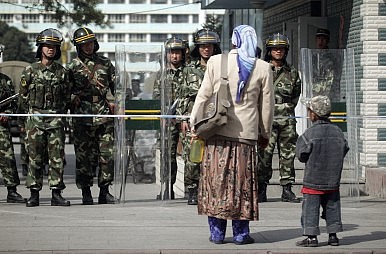With violent attacks on the rise in Xinjiang, much debate surrounds the underlying causes of violence in the region. While Chinese authorities blame Uyghur separatists, armed jihadism encouraged from abroad, and economic inequality in the region, other observers point to regional policies that increasingly restrict Uyghur’s cultural and religious practices. China-Uyghur relations scholar Liam Powers offers an alternative analysis, viewing rising tensions in China’s far west through a historical model of hegemony. From The Diplomat:
Although many Uyghurs are undoubtedly infuriated by these restrictions, I am inclined to agree with Jacob Zenn of the Jamestown Foundation: They do not likely compel people to kill. In fact as early as 2006, I was told by several Uyghurs that veils and long beards were banned in public, students were required to eat during Ramadan (if the academic year and Ramadan overlap), and Party officials were forbidden from entering mosques. In other words, sweeping policies aimed at curbing religious practice were set in motion long ago, not to mention that similar policies banning strict veiling in France have not been met by violent opposition.
How, then, can we explain the escalation in violence? The answer may be found in a critical examination of Beijing’s colonial relationship with its far-western region.
To help us reconsider Beijing’s rule in Xinjiang and the recent unrest, we turn to an unlikely source: Charles Maier’s Among Empires. In his attempt to challenge our understanding of U.S. hegemony in global affairs, the Harvard University professor provides a blueprint for empire that considers recurring processes and structures of historical examples. The basics of Maier’s model may be used as an instructive theoretical lens for bringing clarity to the underlying sources of Uyghur unrest. […] [Source]
Click through for Powers’ full analysis.
As in Buddhist Tibet and areas of China with a noticeable and rising population of Christians, Beijing’s worry that religiosity could counter central rule is much a part of the current crackdown in Xinjiang; amid the crackdown, restrictions on Ramadan observance and Islamic dress have been recently enacted. At TIME, Hannah Beech notes that while the Uyghurs see their religion being tightly controlled, China’s predominately Muslim Hui minority are enjoying a “religious boom”:
With violent unrest affecting northwestern Xinjiang, a spotlight has been cast on that area’s Muslim Uighurs, who have long chafed at rule from Beijing. But the Uighurs, some of whom yearn for autonomy from the People’s Republic, are not the biggest Muslim population in China, which has more adherents to Islam than the European Union. That distinction belongs to the Hui, a 10.5 million-strong group that is also the second largest of China’s 55 officially recognized ethnic minorities. One of the Hui centers of Islamic learning is the Wild West town of Linxia, in Gansu province, where Sufi traditions remain vibrant.
[…] Linxia’s Islamic places of worship are just one symbol of this religious boom. Ismail, a Hui who works for a state-owned enterprise in the Ningxia autonomous region, says he openly practices his faith. “Of course, I fast during Ramadan,” he says. “All my Hui friends do it, too. It’s our obligation as Muslims.” But a Uighur college student says he and his classmates were not allowed to do the same. […]
[…] “It’s not an issue of freedom of religion,” says Dru Gladney, one of the foremost academics studying Chinese Muslims. “Clearly, there are many avenues of religious expression that are unfettered in China, but when you cross these very often nebulous and shifting boundaries of what the state regards as political, then you’re in dangerous territory. Obviously this is what we see in Xinjiang and in Tibet.”
Unlike Tibetans or Uighurs, who speak a Turkic language and are racially distinct from the Han, the Hui are not agitating for increased autonomy, much less a split from China. […] [Source]
For more on ethnic minorities and state oppression in China, reviews of David Eimer’s The Emperor Far Away: Travels at the Edge of China in the New York Times and from Howard French at the Wall Street Journal.








